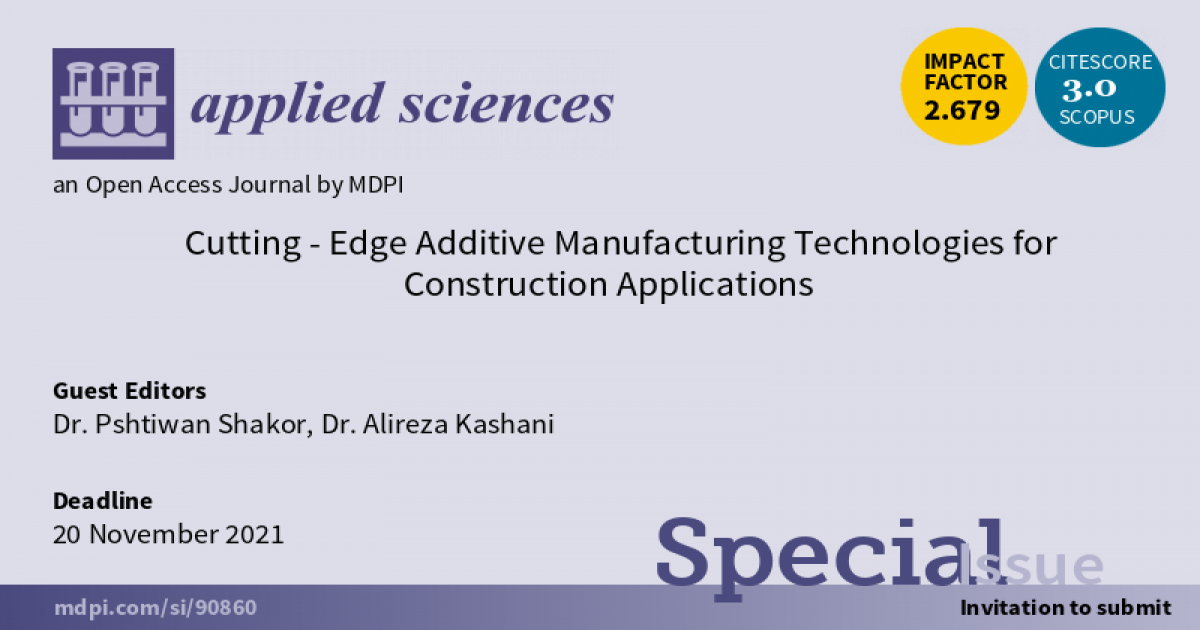- 2.5Impact Factor
- 5.5CiteScore
- 20 daysTime to First Decision
Cutting-Edge Additive Manufacturing Technologies for Construction Applications
This special issue belongs to the section “Additive Manufacturing Technologies“.
Special Issue Information
Dear Colleagues,
Additive Manufacturing (AM) technologies are the most suitable technologies for construction applications in the fourth industrial revolution. Among these techniques extrusion printing, binder jetting (inkjet) printing, powder bed fusion, robocasting and smart dynamic casting are among the most usable printing techniques for construction applications. Extrusion 3D printing is a well-known AM technique for construction printing. However, this is not the only AM technology for construction but also binder jetting is another most promising technique for cementitious and metal printing materials. In addition, other techniques like powder bed fusion will be the future of 3D printing technology for construction applications, particularly in the harsh environment and beyond earth’s application. Steel 3D printing is considered the most vital material for construction purposes, it is required to be investigated further particularly in powder bed fusion. These techniques could be used to create 3D printing composite materials in the cast-in-situ or precast structures, this will be highly efficient to make a sustained environment. Obviously, this could be challenging when printing two different materials in one application. However, there are limited studies that could be found on this topic. This special issue could assist researchers, engineers and scientists to share their new conceptual, experimental, theoretical and numerical methods of AM technology in order to optimise the materials mix design and process. Accordingly, selecting proper materials and AM technologies could be measured as a vital stage to increase the potential of 3D printing for construction applications.
This issue is anticipated to provide a collection of papers presenting a various range of original research and review papers on AM techniques for different materials in construction and outcomes forthcoming perspectives for infrastructure and construction applications.
Dr. Pshtiwan Shakor
Dr. Alireza Kashani
Guest Editors
Manuscript Submission Information
Manuscripts should be submitted online at www.mdpi.com by registering and logging in to this website. Once you are registered, click here to go to the submission form. Manuscripts can be submitted until the deadline. All submissions that pass pre-check are peer-reviewed. Accepted papers will be published continuously in the journal (as soon as accepted) and will be listed together on the special issue website. Research articles, review articles as well as short communications are invited. For planned papers, a title and short abstract (about 250 words) can be sent to the Editorial Office for assessment.
Submitted manuscripts should not have been published previously, nor be under consideration for publication elsewhere (except conference proceedings papers). All manuscripts are thoroughly refereed through a single-blind peer-review process. A guide for authors and other relevant information for submission of manuscripts is available on the Instructions for Authors page. Applied Sciences is an international peer-reviewed open access semimonthly journal published by MDPI.
Please visit the Instructions for Authors page before submitting a manuscript. The Article Processing Charge (APC) for publication in this open access journal is 2400 CHF (Swiss Francs). Submitted papers should be well formatted and use good English. Authors may use MDPI's English editing service prior to publication or during author revisions.
Keywords
- additive manufacturing
- extrusion 3DP
- binder jetting 3DP
- powder bed fusion
- construction materials
- construction application
- curing
- post-processing

Benefits of Publishing in a Special Issue
- Ease of navigation: Grouping papers by topic helps scholars navigate broad scope journals more efficiently.
- Greater discoverability: Special Issues support the reach and impact of scientific research. Articles in Special Issues are more discoverable and cited more frequently.
- Expansion of research network: Special Issues facilitate connections among authors, fostering scientific collaborations.
- External promotion: Articles in Special Issues are often promoted through the journal's social media, increasing their visibility.
- e-Book format: Special Issues with more than 10 articles can be published as dedicated e-books, ensuring wide and rapid dissemination.

